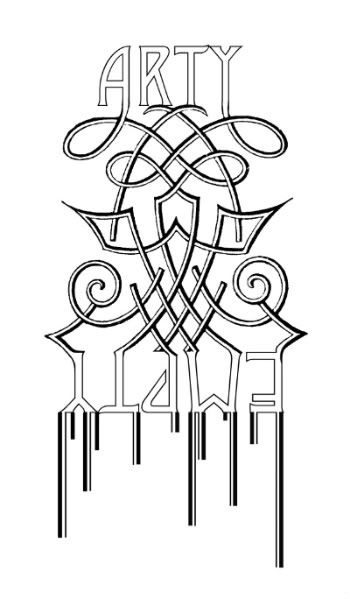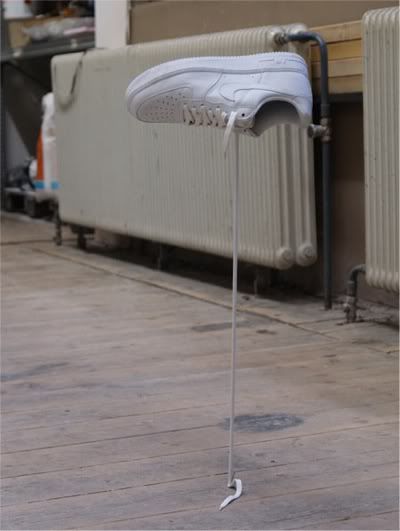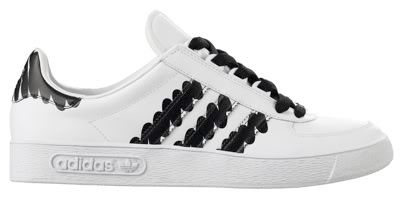Soeur Emmanuelle, presque 100 ans, récemment auréolée du titre honorifique de Femme de l’année (ce qui doit sans doute la bouleverser, où qu’elle soit) est décédée il y a peu de temps. De cette petite religieuse, on retiendra deux choses : une sympathie franche et, il faut bien le dire, un certain dévouement, et sa tenue : coiffe blanche, blouse grise et.... baskets ! Autant dire que ce mode d’accoutrement plantaire a connu un fort joli succès depuis son lancement à la fin du XIXe siècle. Connu sous le nom de baskets ou tennis en France, « athletic shoes » officiellement en pays anglo-saxons, c’est surtout le terme générique de « sneakers » (qui permet de s’échapper sans bruit) qui s’est imposé pour désigner ces chaussures confortables à la semelle de caoutchouc et à l’aise aussi bien sur un terrain de sport qu’en ville.
A la suite de Keds, les marques de sport se sont toutes lancées dans le développement de ce marché fructueux mettant au point des techniques qui relèveraient plus du domaine de l’art, voire de la science-fiction, que du simple concept technologique. Les premières Reebok puis Adidas au début du XXe siècle avec leurs énormes clous traversant la semelle font irrémédiablement penser à l’oeuvre Cadeau de Man Ray, ce fer à repasser parsemé de pointes. Par la suite, la première Nike à la semelle fondue dans un gaufrier (c’est à peu près sûr qu’un « cuisinier » comme Michel Blazy a débuté comme cela), l’évolution des Nike air (des bulles d’air dans la semelle, éloge du vent digne de Loris Gréaud), les Air Jordan (ne mentionnons pas les Ball total equilibrium tank de Jeff Koons mais bien plutôt les envolées légères d’Ernesto Neto), les Pump de Reebok (des chaussures que vous gonflez vous-même, concept irrémédiablement lié à Erwin Wurm) puis les ERS (maîtrise technologique que seul Olafur Eliasson est en mesure d’appréhender) montrent combien les évolutions techniques se confondent avec des pratiques artistiques. On pourrait également prendre l’exemple du coureur éthiopien Abebe Bikila : vainqueur et recordman du marathon en 1960 à Rome.... pieds nus, il réédite le même exploit 4 ans plus tard à Tokyo, avec... des Asics aux pieds. Une telle attitude relève évidemment de l’acte performatif pour le premier, typé body art, et ironie malicieuse pour le second, signé Claude Closky ou Matthieu Laurette.
Dans les traitements singuliers appliqués aux sneakers, on a le fait main version Patrice Gaillard & Claude (en collaboration avec Daniel Dewar) pour la série des Handmade Shoes en cuir et polyuréthane : ES, Stan Smith, DC, Air Max 90. Le duo réinvente les mythes : celui de chaussures iconiques, celui de l’artiste qui travaille méticuleusement à une fabrication quasi artisanale. Johannes Wohnseifer aime taquiner les grandes marques allemandes. On retrouve forcément dans ces cibles la compagnie d’Adi Dassler : collaboration pour the Wohnseifer, 3 exemplaires de chaussures mixant les éléments architecturaux des Jeux Olympiques de Munich avec les travaux d’Otl Aicher. Exposition de 100 paires peintes et retravaillées pour la triennale de Yokohama en 2001, offertes à des spectateurs médusés. José Antonio Hernandez Diez empile les sneakers pour, à l’aide de leur logo, épeler le nom d’un grand penseur : Jung, Kafka, Marx, Hegel, Kant. L’idée n’est pas extraordinaire mais le résultat amusant. Disons que le lien unissant la sneaker au penseur reste quelque peu abscons. Adam Brandejs rejoue l’approche manuelle de Patrice Gaillard & Claude mais en version non végétarienne : une basket fabriquée à partir de chair et de viande. Entre cannibalisme marketing et notion de sacrifice du travail, Nike doit apprécier ce bel hommage... Ala Ebtekar mixe culture iranienne et environnement hip hop dans Elemental, une installation où les sneakers jouent le rôle de médiateurs entre Orient et Occident et incarnent une certaine imagerie de nos sociétés contemporaines. Ricky Swallow tente la version carton dans Vacated Campers et la version bois (avec oiseau intégré) dans Together is the new alone. La maîtrise technique de l’australien impressionne mais doit affronter un classicisme forcené (et ce que cela implique) dans la réalisation. Enfin, Valentin Ruhry dans Nike Air prend la marque au swoosh au pied la lettre et insère un peu de poésie et d’humour dans ces incarnations trop souvent associées au mercantilisme le plus primaire.
En parlant de mercantilisme, une autre stratégie régie les rapports art / sneaker. En effet, nombre d’artistes ont, volontairement ou non, prêté leur nom et leur création aux chaussures les plus diverses. La série Adicolor peut se targuer d’avoir dévoyé des grands noms comme Jim Lambie, Claude Closky, Keith Haring, Taro Okamoto ou Peter Saville. Et, il faut bien le reconnaître, c’est une franche réussite. On ne peut pas franchement blâmer les artistes pour avoir succombé au grand tentateur du merchandising, surtout quand ils sont morts comme Jean-Michel Basquiat ou franchement impliqués comme John Maeda, tous les deux chez Reebok. Quant aux marques, elles se sont toujours inspirées de la création contemporaine. Il suffit de se souvenir que Vans est devenu un acteur majeur du marché du skate suite à la performance de Sean Penn dans Fast Times at Ridgemont High d’Amy Heckerling, en 1982. Vans d’ailleurs dont la réponse publicitaire à l’engagement de Nike sur son marché du skate a été absolument brillante, digne d’un tableau d’Ed Ruscha : « Don’t do it ». Inspiration tout bonnement divine.... Mais au fait, en parlant de Dieu, elle portait quoi comme marque soeur Emmanuelle ?
Don’t do it.
Soeur Emmanuelle, almost 100 years, recently awarded by the honorific Woman of the Year title (that’s probably moves her deeply, wherever she is) died few days ago. From this little nun, we’ll remember two things: a frank sympathy, and to be perfectly honest, a kind of dedication, and her clothes: a white wimple, a grey blouse and... sneakers! Let’s say that this plantar getup get successful since its launch at the end of the XIXth century. Athletic shoes or more commonly sneakers (to sneak) refer to comfortable shoes with rubber soles as at ease on playgrounds as on city streets.
Concerning particular treatments artists do to sneakers, we have the hand-made version by Patrice Gaillard & Claude (in collaboration with Daniel Dewar) for the Handmade Shoes series, in polyurethane and leather: ES, Stan Smith, DC, Air Max 90. The duet reinvents myths: iconic shoes, artist meticulously working on handcrafted fabrication. Johannes Wohnseifer likes to tantalize big German brands, including obviously the Adi Dassler company. He collaborated for the Wohnseifer, 3 specimens of shoes mixing architectural elements of the Olympic Games in Munich with Otl Aicher works. He exhibited too 100 pairs of painted and reconstructed shoes for the Yokohama Triennial on 2001, and offered them to dumbfounded spectators. Jose Antonio Hernandez piles sneakers up to, thanks to their logo, spell the name of a great thinker: Jung, Kafka, Marx, Hegel, Kant. The idea is not extraordinary but the result is funny. Well, the link between sneakers and thinkers is quite abstruse. Adam Brandejs replays the manual approach of Patrice Gaillard & Claude but on a non-vegetarian version: a sneaker made of flesh and meat. Between marketing cannibalism and work sacrifice notion, Nike undoubtedly appreciates this homage... Ala Ebtekar mixes Iranian culture with hip-hop environment on Elemental, an installation where sneakers play the role of mediators between Orient and Occident and incarnate a certain imagery of our contemporary societies. Ricky Swallow tries the cardboard version on Vacated Campers and the wood version (with bird integrated) on Together is the new alone. The technical mastery of the Australian artist impresses but has to confront to furious classicism (and what it implies) on realization. Finally, Valentin Ruhry on Nike Air takes the swoosh brand to the letter and puts poetry and humor on these incarnations always connected to primary mercantilism.
Mentioning mercantilism, another strategy governs the art / sneaker relationship. Numerous artists associated, voluntarily or not, their name and creations to various shoes. The Adicolor series can be proud to quote Jim Lambie, Claude Closky, Keith Haring, Taro Okamoto or Peter Saville, as participants. And it’s a great aesthetic success. We cannot blame artists for giving in to merchandising temptation, especially when they are dead like Jean-Michel Basquiat, or honestly and deeply implicated like John Maeda, both with Reebok. Concerning brands, they have always been inspired by contemporary creation. Let’s remember that Vans became a leader on skate market after the great acting of Sean Penn on Fast Times at Ridgemont High by Amy Heckerling in 1982. Vans whom advertising answer to Nike involvement on its skate market has been absolutely brilliant, fit for an Ed Ruscha painting: “Don’t do it”. A merely divine inspiration.... But, talking about God, what brand Soeur Emmanuelle wore?



Aucun commentaire:
Enregistrer un commentaire